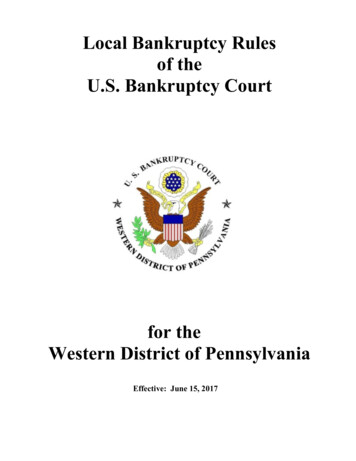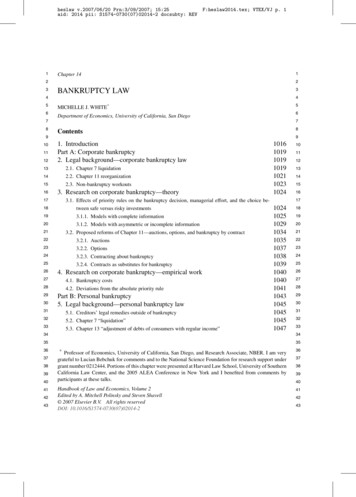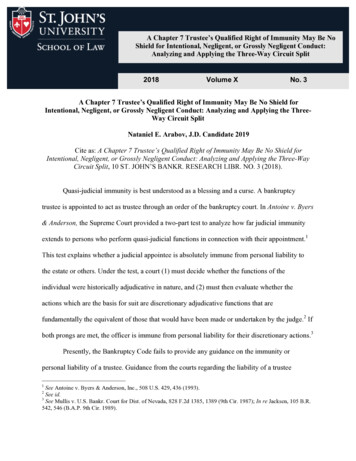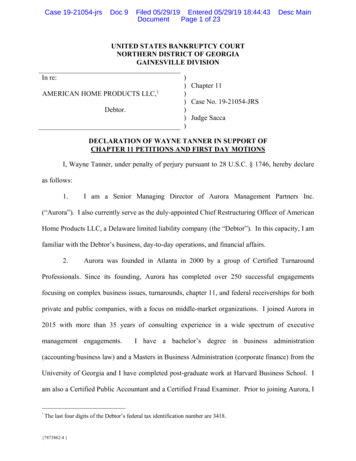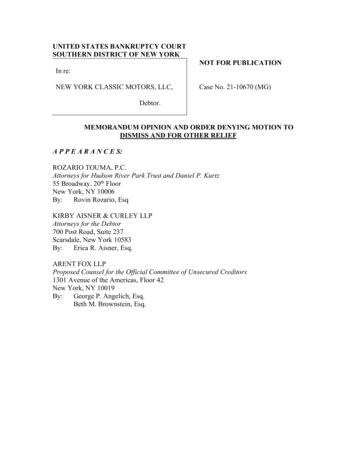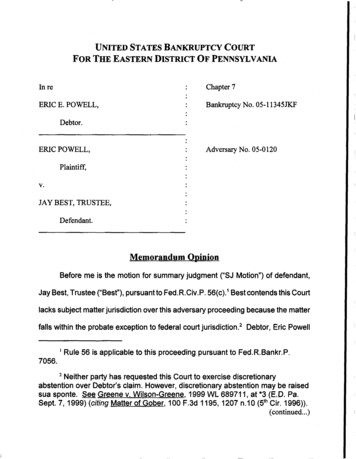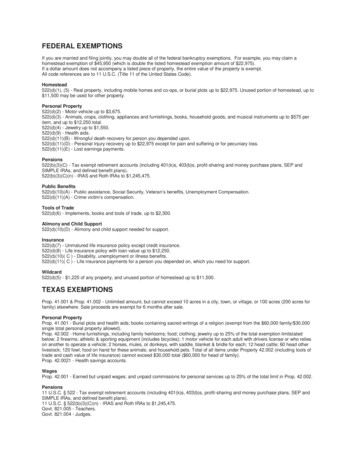
Transcription
FEDERAL EXEMPTIONSIf you are married and filing jointly, you may double all of the federal bankruptcy exemptions. For example, you may claim ahomestead exemption of 45,950 (which is double the listed homestead exemption amount of 22,975).If a dollar amount does not accompany a listed piece of property, the entire value of the property is exempt.All code references are to 11 U.S.C. (Title 11 of the United States Code).Homestead522(d)(1), (5) - Real property, including mobile homes and co-ops, or burial plots up to 22,975. Unused portion of homestead, up to 11,500 may be used for other property.Personal Property522(d)(2) - Motor vehicle up to 3,675.522(d)(3) - Animals, crops, clothing, appliances and furnishings, books, household goods, and musical instruments up to 575 peritem, and up to 12,250 total.522(d)(4) - Jewelry up to 1,550.522(d)(9) - Health aids.522(d)(11)(B) - Wrongful death recovery for person you depended upon.522(d)(11)(D) - Personal injury recovery up to 22,975 except for pain and suffering or for pecuniary loss.522(d)(11)(E) - Lost earnings payments.Pensions522(b)(3)(C) - Tax exempt retirement accounts (including 401(k)s, 403(b)s, profit-sharing and money purchase plans, SEP andSIMPLE IRAs, and defined benefit plans).522(b)(3)(C)(n) - IRAS and Roth IRAs to 1,245,475.Public Benefits522(d)(10)(A) - Public assistance, Social Security, Veteran’s benefits, Unemployment Compensation.522(d)(11)(A) - Crime victim’s compensation.Tools of Trade522(d)(6) - Implements, books and tools of trade, up to 2,300.Alimony and Child Support522(d)(10)(D) - Alimony and child support needed for support.Insurance522(d)(7) - Unmatured life insurance policy except credit insurance.522(d)(8) - Life insurance policy with loan value up to 12,250.522(d)(10)( C ) - Disability, unemployment or illness benefits.522(d)(11)( C ) - Life insurance payments for a person you depended on, which you need for support.Wildcard522(d)(5) - 1,225 of any property, and unused portion of homestead up to 11,500.TEXAS EXEMPTIONSProp. 41.001 & Prop. 41.002 - Unlimited amount, but cannot exceed 10 acres in a city, town, or village, or 100 acres (200 acres forfamily) elsewhere. Sale proceeds are exempt for 6 months after sale.Personal PropertyProp. 41.001 - Burial plots and health aids; books containing sacred writings of a religion (exempt from the 60,000 family/ 30,000single total personal property allowed).Prop. 42.002 - Home furnishings, including family heirlooms; food; clothing; jewelry up to 25% of the total exemption limitstatedbelow; 2 firearms; athletic & sporting equipment (includes bicycles); 1 motor vehicle for each adult with drivers license or who relieson another to operate a vehicle; 2 horses, mules, or donkeys, with saddle, blanket & bridle for each; 12 head cattle; 60 head otherlivestock; 120 fowl; food on hand for these animals; and household pets. Total of all items under Property 42.002 (including tools oftrade and cash value of life insurance) cannot exceed 30,000 total ( 60,000 for head of family).Prop. 42.0021 - Health savings accounts.WagesProp. 42.001 - Earned but unpaid wages; and unpaid commissions for personal services up to 25% of the total limit in Prop. 42.002.Pensions11 U.S.C. § 522 - Tax exempt retirement accounts (including 401(k)s, 403(b)s, profit-sharing and money purchase plans, SEP andSIMPLE IRAs, and defined benefit plans).11 U.S.C. § 522(b)(3)(C)(n) - IRAS and Roth IRAs to 1,245,475.Govt. 821.005 - Teachers.Govt. 821.004 - Judges.
Govt. 821.006 - County and district employees.Govt. 615.005 - Law enforcement officers, firefighters, and emergency medical personnel's survivors.6243d-1 - Police officers.6243e - Firefighters.6243h & Govt. 811.005 - State employees, elected officials, and municipal employees.Prop. 42.0021- ERISA-qualified church or government benefits, including IRAs and Keoghs; retirement benefits to extent taxdeferred.Public BenefitsLabor 207.075 - Unemployment compensation.Labor 408.201 - Workers' compensation.Crim. Proc. 56.49 - Crime victims' compensation.Hum-Res. 31.040 - Public assistance.Hum-Res. 32.036 - Medical assistance.Tools of TradeProp. 42.002 - Tools, books, and equipment, including motor vehicles and boats used in trade or profession; and farming orranching vehicles and implements. Tools of trade exemptions are included in the total limit listed under Personal Property, above.InsuranceInsur. 1551.011 - Texas employee uniform group insurance.Insur. 1575.006 - Texas public school employees group insurance.Insur. 1601.008 - Texas state college or university employee benefits.Insur. 885.316 - Fraternal benefit society benefits.Insur. 1108.051 - Life, health, accident or annuity benefits, policy proceeds, cash values and monies due or already paid tobeneficiary or insured.MiscellaneousProp. 42.001 - Alimony and child support.Educ. 54.709 - Higher education savings plan trust account.Alco. Bev. Code 11.03 - Liquor permits and licenses.Educ. 54.639 - Prepaid tuition plansARKANSAS EXEMPTIONSHomestead (Choose A or B, Not Both)A. 16-66-210 - Married person or head of family may claim: Real or personal property used as a residence; unlimited exemption upto 1/4 acre in a city, town, or village; or up to 80 acres elsewhere. If between 1/4 and 1 acre in city, town, or village, or 80 to 160acres elsewhere, additional exemption up to 2,500. No homestead may exceed 1 acre in city, town, or village, or 160 acreselsewhere. Spouses may not double.B. 16-66-218 - Real or personal property used as a residence, up to 800 if single or 1,250 if married.Wearing ApparelYou can keep all of your clothing under Arkansas law. Ark. Const. art. IX, §§ 1 and 2).Other Personal PropertyWhile Arkansas does have a bankruptcy exemption statute on the books, which delineates various exemption amounts for certaintypes of personal property (see Ark. Code Ann. § 16-66-218 ), in 1990 the Eight Circuit Court of Appeals declared this statuteunconstitutional as it relates to personal property. In re Holt, 894 F.2d 1005 (8th Cir. 1990). The court reasoned that becauseArkansas has a constitutional provision which allows debtors to exempt up to 200 of all of their personal property ( 500 if married)(see Ark. Const. art. IX, §§ 1 and 2), this provision acted as a cap. The bankruptcy exemption statute (which allows for moregenerous exemption amounts) conflicts with the Constitution and is therefore unconstitutional.These caps apply to all of your personal property. So, for example, if you are single and use 200 to exempt car equity, you'll havenothing left for your piano.Public Benefits11-9-110 - Workers' compensation.11-10-109 - Unemployment compensation.16-90-716 - Crime victims' compensation.Other : Add any applicable Federal Nonbankruptcy Exemptions.
If you select your state's bankruptcy exemptions (in many cases, that is your only option), you may also use a set of additionalexemptions called the federal nonbankruptcy exemptions. These exemptions are in addition to the exemptions available in yourstate system. However, you cannot use the federal nonbankruptcy exemptions if you choose to use the Federal BankruptcyExemptions.Retirement Benefits5 USC § 8346 - Civil Service employees.22 USC § 4060 - Foreign service employees.10 USC § 1440 - Military service employees.45 USC § 231m - Railroad workers.42 USC § 407 - Social Security benefits.38 USC § 3101 - Veteran's benefits.50 USC § 403 - CIA employees.38 USC § 1562(c) - Military Medal of Honor Roll pensions.Survivor's Benefits10 USC § 1450 - Military service.28 USC § 376 - Judges, U.S. court directors, judicial center directors, and U.S. Supreme Court Chief Justice's administrativeassistants.33 USC. §775 - Lighthouse workers.Death and Disability Benefits5 USC § 8130 - Government employees.33 USC § 916 - Longshoremen, harbor workers.42 USC § 1717 - War, risk, hazard, death, or injury compensation.Misc.10 USC § 1035 - Military deposits to savings accounts (while on permanent duty outside the U.S.).15 USC § 1673 - 75% of earned but unpaid wages or 30 times the federal minimum hourly wage; the greater of these two. (Judgemay approve more.)25 USC § 410 - Indian lands or homestead sales or lease proceeds.25 USC §§ 543 & 545 - Klamath Indian tribe benefits for those living in Oregon; agricultural or grazing lands to 5,000.38 USC § 1970(g) - Military group life insurance45 USC § 352(e) - Railroad workers' unemployment46 USC § 11110 - Seamen's clothing46 USC § 11111 - Debts of a seaman incurred while on a voyage46 USC § 11109 - Seamen's wages (except for spousal or child support)38 USC §1970(g) - Life insurance benefits for serviceman's Group Life Insurance or Veteran's Group Life InsuranceIn re Carol H. and Don L. Ling, 24 CBN 562, 2014 WL 2442151(Bank. S.D. Texas 5/30/14)MEMORANDUM OPINIONBackgroundMr. and Mrs. Ling were granted a discharge in their chapter 7 bankruptcy case on March 7, 2014. (ECF No. 23). Mr.and Mrs. Ling claimed their entire 37.41 acre property as exempt homestead property on their Schedule C. (ECF No.1 at 14). The Court held a hearing on the McLaughlins’ Objection on March 6, 2014. Mrs. Ling testified that the37.41 acre property consists of three separate, contiguous tracts of land.1 Exhibit 1 from the hearing is a survey ofthe boundary lines for each tract owned by the Lings and their neighbors’ adjoining properties. The Lings’ home islocated on a 4.69 acre tract of land, which is adjoined by a 15.07 acre tract of land to the southeast. On the other sideof a county road, Jack Rabbit Lane, the Lings own a 17.7 acre tract of land.2 Jack Rabbit Lane separates the Lings’property so that the 15.07 acre tract and the 4.69 acre tract are located to the southeast of the road and the 17.7 acretract is located to the northwest of the road. In 1994, the Lings purchased the 15.07 acre tract and the 4.69 acre tract.The 15.07 acre tract is in Mr. Ling’s name, and the 4.69 acre tract is in Mrs. Ling’s name. The Lings’ house islocated on the 4.69 acre tract. It is undisputed that (i) the Lings are entitled to homestead protection on the 4.69 acretract and (ii) the 15.07 acre tract is contiguous to the 4.69 acre tract. At the hearing, Mrs. Ling stated that the Lingshad a small farming operation on these tracts until 2006. She also testified that they actively hunt deer hunt on thesetracts. In 2002, the Lings bought the 17.7 acre tract. Mrs. Ling testified that they picked wild grapes and berries onthe 17.7 acre tract. She also stated that they unsuccessfully attempted to farm on some meadow areas located on thistract. Mrs. Ling testified that when they purchased the 17.7 acre tract of land, Robertson County held an easement
over Jackrabbit Lane. According to Mrs. Ling, in 2004 the Lings agreed to expand Robertson County’s easementfrom .192 acres to .5 acres so that the County could build a two-lane bridge on Jackrabbit Lane. The Lings assertthat they own the land underneath the road and that Robertson County only possesses an easement. This testimonywas not disputed by the McLaughlins.Standard for Establishing Homestead ExemptionUnder Texas law, a claimant may establish homestead rights in his land by showing (i)overt acts of homestead usageand (ii) the intention on the part of the owner to claim the land as a homestead. Once the claimant has made a primafacie case in favor of homestead status, the objecting party has the burden of demonstrating that the homesteadrights have been terminated. Fed. R. Bankr. P. 4003. A rural homestead may consist of “not more than 200 acres,which may be in one or more parcels, with the improvements thereon.” Tex. Prop. Code Ann. § 41.002(b).When the debtor actually resides on the property, “a court generally need not investigate intent because that is ‘themost satisfactory and convincing evidence of intention.”’ PaineWebber Inc. v. Murray, 260 B.R. 815, 822–823(E.D. Tex. 2001). When a party is claiming rural homestead protection on a separate tract of land from where theylive, that “uninhabited property must be used in connection with the home tract for the comfort, convenience, orsupport of the family.” In re Webb, 263 B.R. 788, 792 (Bankr. W.D. Tex. 2001). However, courts have distinguishedseparate tracts that are not contiguous from separate tracts that are contiguous. Painewebber Inc. v. Murray, 260B.R. 815, 830 (E.D. Tex. 2001). In Painewebber, the court explains the significance of this distinction: “With acontiguous tract, one can logically extend the establishment of a home and the activities pertaining to the home tothe outer boundaries of that tract. Only an imaginary line separates the residence tract from the contiguous property.Hence, there is a presumption that such a tract is used for the purposes of a home. With a noncontiguous tract, morethan an artificial boundary separates it from the home.” PaineWebber, Inc. v. Murray, 260 B.R. 815, 830 (E.D. Tex.2001).The court in In re Mitchell further explains the policy reasons for presuming that contiguous tracts are used forpurposes of the home: Although never explicitly stated, there appears to be a presumption that landcontiguous to the homestead under Texas law is used for the purposes of a home. The reasoning behind thisdistinction between contiguous and non-contiguous rural tracts, although not clear and unstated, can easily be seenand justified for policy reasons. First, although homestead laws are to be liberally construed, their purpose is not toprotect the claimant's land, but rather his homestead, i.e., his residence. Where the tracts are not adjacent to theresidential tract they cannot said to be used “for the purposes of a home” in any immediate sense, so it isadditionally required that they further the purposes of the home by being used in a manner consistent with economicneeds or for the convenience or comfort of the home. In re Mitchell, 132 B.R. 553, 565-66 (Bankr. W.D. Tex.1991)(internal citations omitted). For determining whether a contiguous tract is eligible for homestead protection,courts have held that supportive acts conducted on one tract are presumptively extended to separate, contiguoustracts. PaineWebber, Inc. v. Murray, 260 B.R. 815 (E.D. Tex. 2001). For a noncontiguous tract, a claimant mustdemonstrate that the tract supports the home. The McLaughlins do not dispute that the Lings are entitled tohomestead protection for the 4.69 acre tract where their home is located. The McLaughlins request that the Courtsustain their objection to the 15.07 acre tract and the 17.7 acre tract of land. (ECF No. 13 at 4).AnalysisBefore discussing whether the activities on each of the two tracts at issue are sufficient for homestead protection, theCourt must first determine whether each tract is contiguous to the 4.69 acre tract where the Lings reside. TheMcLaughlins do not dispute the Lings’ contention that the 15.07 acre tract and the 4.69 acre tract are contiguous.The McLaughlins do argue that 17.7 acre tract is not contiguous to the 4.69 acre tract because they are separated bythe county road. For the reasons set forth below, the Court finds that the 17.7 acre tract is also contiguous to the 4.69acre tract. Accordingly, the Court finds that the homestead character of the 4.69 acre tract presumptively extends toeach of these contiguous tracts.Contiguous TractsContiguous means “touching at a point or along a boundary; adjoining.” Black's Law Dictionary (9th ed. 2009). InIn re Schott, the court stated that for two tracts of land to be contiguous, they must be adjoining, which requires thatthey touch or have physical contact at some point. In re Schott, 449 B.R. 697, 702 (Bankr. W.D. Tex. 2011). If acounty road is standing between two tracts of land, that road may constitute an intervening object that preventsthe tracts of land from having physical contact with each other, rendering the land not contiguous. Id. at 702-03.However, several courts have found parcels of land to be contiguous for purposes of a rural homestead when a road
bisects the land if the county possesses an easement and the property owner holds title to the land underneath theroad. See Int'l & G.N.R. Co. v. Boles, 161 S.W. 914 (Tex. Civ. App. 1913)(concluding that “because the propertyowner still held title to the land over which the right of way passed (the county merely possessed an easement), theparcels were, in fact contiguous.”); See also Youngblood v. Youngblood, 124 Tex. 184, 76 S.W.2d 759(Tex.1934)(concluding that land on one side of a road used by the public was contiguous to land on the other side ofthe road where title to the land over which the road passed was held by the owner of the adjoining lands). The courtin In re Schott distinguished those cases and held that the property was not contiguous because the debtor did notown the land beneath the road that bisected his property. In re Schott, 449 B.R. 697, 703 (Bankr. W.D.Tex. 2011).The Court finds that the 17.7 acre tract is contiguous to the 4.69 acre tract. Mrs. Ling testified that the Lings havealways owned the land underneath the road. She explained that when they purchased the 17.7 acre tract of land,Robertson County held an easement across Jackrabbit Lane. In 2004, the Lings merely agreed to expand the widthof the easement from .19 acres to .5 acres so that the county could build a bridge. This testimony was not disputedby the McLaughlins. Accordingly, the Court finds that the 17.7 acre tract is contiguous to the 4.69 acre tract.Eligibility for Rural Homestead ProtectionThe McLaughlins have not disputed that the Lings are entitled to homestead protection on the 4.69 acre tract wheretheir home is located. Because both of the disputed tracts (the 15 acre tract and the 17.7 acre tract) are contiguous tothe 4.69 acre tract, the Court will presume that they are used for purposes of the home. Accordingly, the Lings areentitled to rural homestead protection for the entire 37.41 acre tract. Alternatively, if the two disputed tracts were notcontiguous, the Lings have independently established that each tract is eligible for rural homestead protection. Fornoncontiguous tracts to qualify as part of a rural homestead, one of the tracts must be used as a residence and theother tract(s) must be used for the “comfort, convenience or support of the family.” See In re Schott, 449 B.R. 697,702 (Bankr. W.D. Tex. 2011); See also In re Perry, 345 F.3d 303, 318 (5th Cir. 2003)(if part of rural property isnoncontiguous to property on which the home is situated, then, to constitute part of the homestead, the separate landmust be “used principally for the purposes of a home”); In re Baker, 307 B.R. 860, 863 (Bankr.N.D.Tex.2003)(“Ifthe party claiming rural homestead protection resides on a separate tract of land, the uninhabited property must beused in connection with the home tract for the comfort, convenience, or support of the family.”); In re Webb, 263B.R. 788, 792 (Bankr.W.D.Tex.2001) (“Both the express language of § 41.002(b) and the case law make it clear thatproperty separated from the tract where the residence is located, to be included in a rural homestead, must be ‘usedfor home purposes.’”). Permissible acts of homestead usage that meet the standard of “comfort, convenience, orsupport of the family” vary. See In re Schott, 449 B.R. 697, 702 (Bankr. W.D. Tex. 2011). Most courts have heldthat activities like cultivating crops, pasturing livestock, or chopping wood are sufficient to show that the land isused to support the family. Id. In Perry, the Fifth Circuit noted that separate property has been considered as part ofthe homestead in cases where the owner has indicated use of the land as a pasture, garden, horse lot, or a playgroundfor children in the family, as long as it was used in connection with the residence. Perry v. Dearing (In rePerry), 345 F.3d 303, 318 (5th Cir. Tex. 2003). It is not required that the tract be used to economically support thefamily. Painewebber Inc. 260 B.R. at 828.Mrs. Ling testified that the Lings have conducted the activities on the 15.07 acre tract including (i) a small farmingoperation before Mr. Ling got sick in 2006; (ii) hunting deer; (iii) gathering firewood for the house. These activitiesare for the “comfort, convenience, or support of the family.” Mrs. Ling testified that the Lings have used the 17.7acre tract to (i) pick wild grapes, berries and pears to turn into jam, (ii) maintain a vegetable garden, (iii) gatherfirewood, and (iv) farm (unsuccessfully) some meadow areas in the past. These activities are consistent with therequirement that the property be used for the “comfort, convenience, or support of the family.”“Homesteads are favorites of the law, and are liberally construed by Texas courts.” In re Perry,345 F.3d 303, 316 (5th Cir. 2003). Most Texas courts have held that activities like cultivatingcrops and chopping wood are sufficient to show that the land is used to support the family.Some courts have even held that using separate property as a as a pasture, garden, horse lot, or aplayground for children is sufficient. The Fifth Circuit in In re Perry stated that the Court is“obligated to interpret Texas homestead laws equally broadly in order to effectuate their purposeof protecting the family home ” In re Perry, 345 F.3d 303, 316 (5th Cir. 2003). Although theLings’ current activities on these two tracts are not pervasive, they are minimally sufficient underTexas Homestead law. Accordingly, even if the Court assumes that these two tracts are notcontiguous to the 4.69 acre tract, each tract is independently eligible for rural homesteadprotection.
The McLaughlins’ Abandonment ArgumentThe McLaughlins suggested that the Lings have somehow abandoned their homestead rights on these two tractsbecause their current use of the land is far more sporadic than in previous years. Once homestead status has beencreated, it can only be terminated by total abandonment, which can only be satisfied by the owner’s death,abandonment or alienation. In re Schott, 449 B.R. at 707. Abandonment requires the owner to voluntarily vacate theproperty with the intent to never return. Id. In this case, the McLaughlins have not demonstrated that the Lings haveabandoned their homestead rights. Although the tracts are no longer used for productive farming, Mrs. Ling testifiedshe currently hunts deer and picks grapes, berries and pears on these tracts. The Lings’ sporadic use of these twotracts is insufficient evidence to establish total abandonment. Accordingly, the McLaughlins’ Objection is overruled.ConclusionThe Court will enter an Order consistent with this Memorandum Opinion.SIGNED May 30, 2014.STERN, EXECUTOR OF THE ESTATE OF MARSHALL v. MARSHALL,EXECUTRIX OF THE ESTATE OF MARSHALL CERTIORARI TO THE UNITEDSTATES COURT OF APPEALS FOR THE NINTH CIRCUITNo. 10–179. Argued January 18, 2011—Decided June 23, 2011-Article III, §1, of the Constitutionmandates that “[t]he judicial Power of the United States, shall be vested in one supreme Court, and insuch inferior Courts as the Congress may from time to time ordain and establish,” and provides that thejudges of those constitutional courts “shall hold their Offices during good Behavior” and “receive fortheir Services[ ] a Compensation[ ] [that] shall not be diminished” during their tenure. The questionspresented in this case are whether a bankruptcy court judge who did not enjoy such tenure and salaryprotections had the authority under 28 U. S. C. §157 and Article III to enter final judgment on acounterclaim filed by Vickie Lynn Marshall (whose estate is the petitioner) against Pierce Marshall(whose estate is the respondent) in Vickie’s bankruptcy proceedings. Vickie married J. Howard MarshallII, Pierce’s father, approximately a year before his death. Shortly before J. Howard died, Vickie filed asuit against Pierce in Texas state court, asserting that J.Howard meant to provide for Vickie through atrust, and Pierce tortiously interfered with that gift. After J. Howard died, Vickie filed for bankruptcy infederal court. Pierce filed a proof of claim in that proceeding, asserting that he should be able to recoverdamages from Vickie’s bankruptcy estate because Vickie had defamed him by inducing her lawyers totell the press that he had engaged in fraud in con-trolling his father’s assets. Vickie responded by filing acounterclaim for tortious interference with the gift she expected from J. Howard. The Bankruptcy Courtgranted Vickie summary judgment on the defamation claim and eventually awarded her hundreds ofmillions of dollars in damages on her counterclaim. Pierce objected that the Bankruptcy Court lackedjurisdiction to enter a final judgment on that counterclaim because it was not a “core proceeding” asdefined by 28 U. S. C. §157(b)(2)(C). As set forth in §157(a), Congress has di-vided bankruptcyproceedings into three categories: those that “aris[e] under title 11”; those that “aris[e] in” a Title 11case; and those that are “related to a case under title 11.” District courts may refer all such proceedingsto the bankruptcy judges of their district ,and bankruptcy courts may enter final judgments in “all coreproceedings arising under title 11, or arising in a case under title 11.”§§157(a), (b)(1). In non-coreproceedings, by contrast, a bankruptcy judge may only “submit proposed findings of fact andconclusions of law to the district court.” §157(c)(1). Section 157(b)(2) lists 16 categories of core
proceedings, including “counterclaims by the estate against persons filing claims against the estate.”§157(b)(2)(C).The Bankruptcy Court concluded that Vickie’s counterclaim was a core proceeding. The District Courtreversed, reading this Court’s precedent in Northern Pipeline Constr. Co. v. Marathon Pipe Line Co., 458U. S. 50, to “suggest[ ] that it would be unconstitutional to hold that any and all counterclaims are core.”The court held that Vickie’s counterclaim was not core because it was only somewhat related to Pierce’sclaim, and it accordingly treated the Bankruptcy Court’s judgment as proposed, not final. Although theTexas state court had by that time conducted a jury trial on the merits of the par-ties’ dispute andentered a judgment in Pierce’s favor, the District Court went on to decide the matter itself, in Vickie’sfavor. The Court of Appeals ultimately reversed. It held that the Bankruptcy Court lacked authority toenter final judgment on Vickie’s counter-claim because the claim was not “so closely related to [Pierce’s]proof of claim that the resolution of the counterclaim is necessary to re-solve the allowance ordisallowance of the claim itself.” Because that holding made the Texas probate court’s judgment theearliest final judgment on matters relevant to the case, the Court of Appeals held that the District Courtshould have given the state judgment preclusive effect.Held: Although the Bankruptcy Court had the statutory authority to enter judgment on Vickie’scounterclaim, it lacked the constitutional authority to do so. Pp. 6–38.EXECUTIVE BENEFITS INSURANCE AGENCY v. ARKISON, CHAPTER 7 TRUSTEE OF ESTATE OFBELLINGHAM INSURANCE AGENCY, INC. CERTIORARI TO THE UNITED STATES COURT OFAPPEALS FOR THE NINTH CIRCUITNo. 12–1200. Argued January 14, 2014—Decided June 9, 2014-Bellingham Insurance Agency, Inc. (BIA),filed a voluntary chapter 7bankruptcy petition. Respondent Peter Arkison, the bankruptcy trustee, fileda complaint in the Bankruptcy Court against petitioner Executive Benefits Insurance Agency (EBIA) andothers alleging the fraudulent conveyance of assets from BIA to EBIA. The Bankruptcy Court grantedsummary judgment for the trustee. EBIA appealed tothe District Court, which affirmed the BankruptcyCourt’s decision after de novo review and entered judgment for the trustee. While EBIA’s appeal to theNinth Circuit was pending, this Court held that Article III did not permit a Bankruptcy Court to enter finaljudgment on a counterclaim for tortious interference, even though final adjudication of that claim bythe Bankruptcy Court was authorized by statute. Stern v. Marshall, 564 U. S. , . In light of Stern,EBIA moved to dismiss its appeal for lack of jurisdiction. The Ninth Circuit rejected EBIA’s motion andaffirmed. It acknowledged the trustee’s claims as “Stern claims,” i.e., claims designated for finaladjudication in the bankruptcy court as a statutory matter, but prohibited from proceeding in that wayas a constitutional matter. The Court of Appeals nevertheless concluded that EBIA had impliedlyconsented to jurisdiction. The Court of Appeals also observed that the Bankruptcy Court’s judgmentcould instead be treated as proposed findings of fact and conclusions of law, subject to de novo reviewby the District Court.Held: Under the Bankruptcy Amendments and Federal Judgeship Act of 1984, federal district courts haveoriginal jurisdiction in bankruptcy cases and may refer to bankruptcy judges two statutory categories of
proceedings: “core” proceedings and “non-core” proceedings. See generally 28 U. S. C. §157. In coreproceedings, a bankruptcy judge “may hear and determine . . . and enter appropriate orders andjudgments,” subject to the district court’s traditional appellate review. §157(b)(1). In non-coreproceedings—those that are “not . . . core” but are “otherwise related to a case under title 11,”§157(c)(1)—final judgment must be entered by the district court after de novo review of the bankruptcyjudge’s proposed findings of fact and conclusions of law, ibid., except that the bankruptcy judge mayenter final judgment if the parties consent,§157(c)(2).In Stern, the Court confronted an underlying conflict between the1984 Act and the requirements ofArticle III. The Court held that Article III prohibits Congress from vesting a bankruptcy court with theauthority to finally adjudicate the “core” claim of tortious interference. The Court did not, however,address how courts should proceed when they encounter a Stern claim. Pp. 4–8.Stern claims may proceed as non-c
Mr. and Mrs. Ling were granted a discharge in their chapter 7 bankruptcy case on March 7, 2014. (ECF No. 23). Mr. and Mrs. Ling claimed their entire 37.41 acre property as exempt homestead property on their Schedule C. (ECF No. 1 at 14). The Court held a hearing on the McLaughlins' Objection on March 6, 2014. Mrs. Ling testified that the

